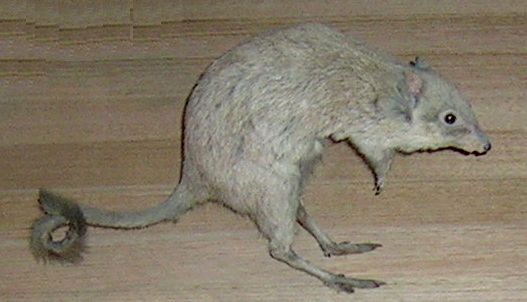- Woylie
Taxobox
name = WoylieMSW3 Groves|pages=57]
status = CR
status_system = iucn3.1
status_ref =

regnum =Animal ia
phylum = Chordata
classis =Mammal ia
infraclassis =Marsupialia
ordo =Diprotodontia
familia =Potoroidae
genus = "Bettongia "
species = "B. penicillata"
binomial = "Bettongia penicillata"
binomial_authority = Gray, 1837The Woylie ("Bettongia penicillata") is a small (30cm long)
marsupial . It is also known as the Brush-tailed Bettong. It is a member of thePotoridae family.The Woylie once inhabited more than 60% of the
Australia n mainland but now occurs only on less than 1%. It is strictlynocturnal and is not gregarious. During the day it rests in a well-made and hiddennest which consists of grass and shredded bark. It digs out food such asbulb s,tuber s andfungi with its strong foreclaws. Its habitat includestemperate forest s and scrubs as well asarid shrubland s andgrassland s.It formerly ranged over all of southwest
Western Australia , most ofSouth Australia , the northwest corner of Victoria and across the central portion ofNew South Wales . It was abundant in the mid-19th century. By the 1920s it was extinct over much of its range. As of 1992 it was reported only from four small areas of Western Australia. In South Australia, a number of populations had been established throughreintroduction of captive-bred animals. As of 1996 it occurred in six sites in Western Australia, includingKarakamia Sanctuary run by theAustralian Wildlife Conservancy (AWC), and on three islands and two mainland sites in South Australia, following the reintroduction program and the controlling of foxes.The bettongs' decline seems to have been caused by a number of factors. These include the impact of introduced
grazing animals, clearing foragriculture , predation by introducedRed Fox es, and possibly changed fire regimes. More recently, a sudden population crash in the remaining areas - a drop of 80 per cent in five years - is due to undetermined causes, though researcher Andrew Thompson has found twoparasite infestations in the Woylie blood [cite episode | author = Leonie Harris | title = Woylie marsupial under threat | series = 7.30 report | airdate =2008-10-07 url=http://www.abc.net.au/7.30/content/2008/s2384667.htm] .The Woylie has an unusual diet for a mammal. Although it may eat bulbs, tubers, seeds, insects and resin, the bulk of its nutrients are derived from underground fungi, which can only be digested indirectly. In a portion of its stomach, the fungi are consumed by bacteria. These
bacteria produce the nutrients that are digested in the rest of the stomach and small intestine.It is able to use its tail, curled around in a
prehensile manner, to carry bundles of nesting material.References
Cited references
General references
* [http://www.wildanimalpark.co.uk/animals/australia/bettong.htm wildanimalpark.co.uk]
Wikimedia Foundation. 2010.
